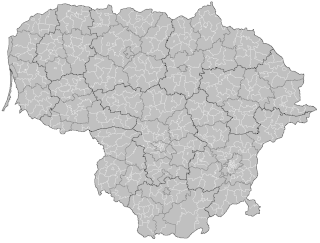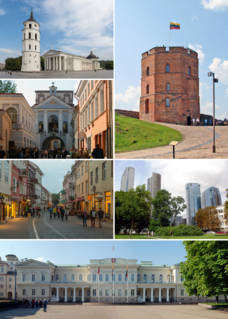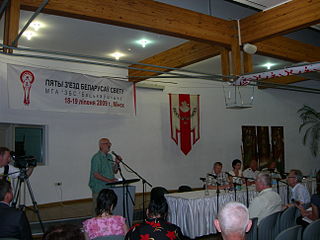Related Research Articles

This article is about the demographic features of the population of Lithuania, including population density, ethnicity, level of education, health, economic status, and religious affiliations.

Vilnius is the capital and largest city of Lithuania, with a population of 588,412 as of 2021. The population of Vilnius's functional urban area, which stretches beyond the city limits, is estimated at 706,832, while according to the Vilnius territorial health insurance fund, there were 732,421 permanent inhabitants as of October 2020 in Vilnius city and Vilnius district municipalities combined. Vilnius is in southeastern Lithuania and is the second-largest city in the Baltic states. It is the seat of Lithuania's national government and the Vilnius District Municipality.

Trakai is a historic city and lake resort in Lithuania. It lies 28 kilometres west of Vilnius, the capital of Lithuania. Because of its proximity to Vilnius, Trakai is a popular tourist destination. Trakai is the administrative centre of Trakai district municipality. The town covers 497.1 square kilometres of area and, according to 2007 estimates, is inhabited by 5,357 people. A notable feature of Trakai is that the town was built and preserved by people of different nationalities. Historically, communities of Karaims, Tatars, Lithuanians, Russians, Jews and Poles lived here.

Lithuanians are a Baltic ethnic group. They are native to Lithuania, where they number around 2,561,300 people. Another million or more make up the Lithuanian diaspora, largely found in countries such as the United States, United Kingdom, Brazil, Russia, and Canada. Their native language is Lithuanian, one of only two surviving members of the Baltic language family along with Latvian. According to the census conducted in 2001, 83.45% of the population of Lithuania identified themselves as Lithuanians, 6.74% as Poles, 6.31% as Russians, 1.23% as Belarusians, and 2.27% as members of other ethnic groups. Most Lithuanians belong to the Catholic Church, while the Lietuvininkai who lived in the northern part of East Prussia prior to World War II, were mostly Evangelical Lutherans.

The Polish diaspora comprises Poles and people of Polish heritage or origin who live outside Poland. The Polish diaspora is also known in modern Polish as Polonia, the name for Poland in Latin and many Romance languages.
Chicago's demographics show that it is a large and ethnically diverse metropolis. It is the third largest city and metropolitan area in the United States by population, and the city was home to over 2.7 million people in 2020, accounting for over 25% of the population in the Chicago metropolitan area; home to approximately 9.6 million. The racial makeup of the city in 2010 was 45.3% white, 32% black, 5% Asian, and 3% from two or more races. The ethnic makeup of the population is 28% Hispanic and 72% belong to non Hispanic background. English is the primary language of the city, and Christianity accounts as the predominant faith.
Burmese Americans are Americans of full or partial Burmese ancestry. The term encompasses people of all ethnic backgrounds with ancestry in present-day Myanmar, regardless of specific ethnicity. They are a subgroup of Asian Americans.
Russians in Lithuania numbered 140,000 people, according to the Lithuanian estimates of 2015, or 4.8% of the total population of Lithuania.
At the 2010 census, there were 1,526,006 people, 590,071 households, and 352,272 families residing in the consolidated city-county of Philadelphia, Pennsylvania. The population density was 4,337.3/km² (11,233.6/mi²). There were 661,958 housing units at an average density of 1,891.9/km² (4,900.1/mi²).

Lithuanian Americans refers to American citizens and residents who are Lithuanian and were born in Lithuania, or are of Lithuanian descent. New Philadelphia, Pennsylvania has the largest percentage of Lithuanian Americans (20.8%) in the United States. Lithuanian Americans form by far the largest group within the Lithuanian diaspora.

The latest (mid-2019 est.) population estimate for the City of Sheffield is 584,853 residents. This represents an increase of about 17,000 people since the last census in 2011.
Minneapolis is the largest city in the U.S. state of Minnesota and the county seat of Hennepin County. As of the 2010 Census, the population of Minneapolis was 382,578.

According to the 2011 census, the predominant religion in Lithuania is Christianity, with the largest confession being that of the Catholic Church. There are smaller groups of Orthodox Christians, Evangelical Lutherans, members of Reformed churches, other Protestants, Jews and Muslims as well as people of other religions.
Vietnamese people in the United Kingdom include British citizens and non-citizen immigrants and expatriates of full or partial Vietnamese ancestry living in the United Kingdom. They form a part of the worldwide Vietnamese diaspora.

The population of Brazil is very diverse, comprising many races and ethnic groups. In general, Brazilians trace their origins from three sources: Europeans, Amerindians and Africans. Historically, Brazil has experienced large degrees of ethnic and racial admixture, assimilation of cultures and syncretism.
Armenians in Lithuania refers to ethnic Armenians living in Lithuania.

The Belarusian diaspora refers to emigrants from the territory of Belarus as well as to their descendants.
Armenians in the Baltic states of Estonia, Latvia, and Lithuania settled there mostly during the Soviet occupation of the Baltic States.
As of the 2011 census, the number of immigrants in Costa Rica totaled about 390,000 individuals, or about 9% of the country's population. Following a considerable drop from 1950 through 1980, immigration to Costa Rica has increased in recent decades.
References
- ↑ Žukovskis, Andrejus. "Kinijos ambasadorius: Lietuvoje viso labo gyvena apie 500 kinų" (in Lithuanian). delfi.lt . Retrieved 2011-06-06.
- ↑ "Vilniaus kinai ima žvalgytis į tėvynę".
- ↑ "Archived copy". Archived from the original on 2011-06-04. Retrieved 2012-01-08.CS1 maint: archived copy as title (link)